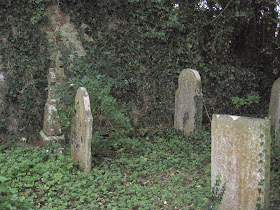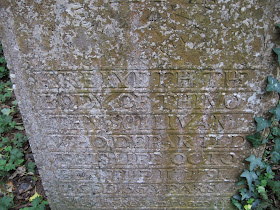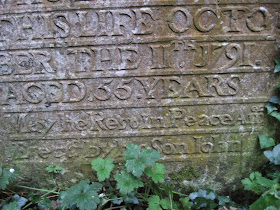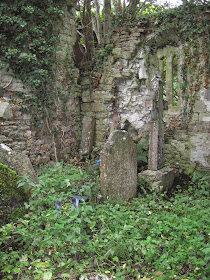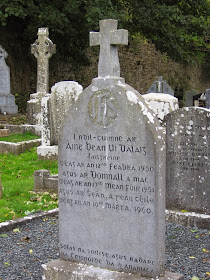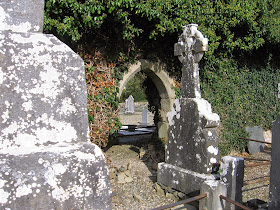While much can be gleaned, researching family records ahead
of a trip overseas, paper trails of ancestors alone cannot provide a full
revelation of what daily life was like for the multiple “greats” in our family tree. On
our recent trip to Ireland
in pursuit of my husband’s roots there, we were glad to be able to walk the
paths in the rural homelands where these immigrant ancestors originated.
In the past few days, I’ve been focusing on what we found
while walking the graveyard of a particular church in the Diocese of Limerick.
This church was not on our original itinerary, but when we pulled into
Ballyagran—the village where our Flanagan ancestors once lived—a current
resident pointed us in the direction of this graveyard.
It turns out this church—now in ruins—had a long and varied
history. It once was part of the Corcomohide parish—namesake of the
civil parish as well—but was carved out of that jurisdiction in 1719.
Originally on land once belonging to the MacEnerys, the
ruling family in the area, the place was once known as Castletown MacEnery. By 1703,
the MacEnery land was obtained by Captain George Conyers. At that point, the
land was referred to as Castletown Conyers.
It wasn’t until the early 1800s that the parish became known
as Ballyagran—the place name that our Flanagan ancestors carried with them to Chicago when they
emigrated from their homeland in the 1850s.
The ruins in the graveyard were apparently from the church
building in use when the parish was part of Corcomohide. An original building from
1200 was destroyed during a war in 1302, and the replacement was not built
until 1410. Whether those walls still standing are part of the remains from the
1410 building, I can’t tell. Unlike what I was able to find at other graveyards we visited, I couldn’t locate any markers explaining this place’s history—although after our return, I
discovered that just down the road from the church was the very castle from which
the graveyard took its name.
According to a wonderful heritage project undertaken by the Diocese of Limerick, the graveyard at Castletown is considered “large.” Despite
priding ourselves on locating a headstone dated from the late 1700s, the
earliest burial still able to be read was apparently that of a Cornelius Ryan, who died in 1737.
When we were walking the paths of the graveyard, my husband
took several photographs of headstones, even though those they commemorated were not related to us. My hope is to post
these photos to Find A Grave—although apparently there is no official entry for that
cemetery currently, so I’ll first have to determine what the official name of the
place should be.
To give you some perspective on the photographs I’ve
included from the last few days, I’m including some pictures to help you gain
your bearings. The cemetery itself sat back from the road—a modest two-lane
country road. The side road leading up to the graveyard seemed to continue
further—to the castle that “Castletown” refers to, oh duh!, as we later found
out—but since it looked like a downpour was imminent, we hustled to park and
see what we could find.
In the middle of the graveyard sat the church ruins, roofless and overgrown with trees. Closer to the street side of the property, there seemed to be more recent burials, but on the back half of the property, and inside the church walls as well, were the older burials.
Clearly legible headstones alternated with more faded
stones. Those which I can read, I’ll transcribe and post on Find A Grave. But
it was one section of low-lying, jagged rocks over which I grieve. Could our
family members be buried under those silent markers? Who knows?
The church walls, themselves, were full of features to
wonder at. The stone work, still standing after centuries, was now interwoven
with massive roots, branches and vines. Narrow windows let in light to the
darker recesses of the building—despite the fact that the building no longer
boasted a roof of its own, the trees furnished an adequate canopy to block much
of the daylight on this gloomy day.
It was apparent that people were buried here from all over
the parish—witness the Deely memorial I posted a few days ago, mentioning the townland of
Rusheen, part of this County Limerick parish which is actually located in neighboring County Cork. As for our Flanagans and Molloys,
however, there was not a sign. Whether their relatives moved to other parishes,
I can’t tell—though more tedium in cranking through microfilmed records for
those neighboring parishes might help tell the tale.
Leaving the church ruins at Castletown was a somber yet
edifying moment. While we didn’t find what we came to see—any headstones for
our family’s surnames—we couldn’t escape without a sense of the simple life led
by the folks who found this to be their final resting place.
All photographs from the Catholic Church ruins and graveyard at Castletown (sometimes referred to as Castletown-Conyers) in County Limerick, Ireland. Photographs courtesy Chris Stevens.
All photographs from the Catholic Church ruins and graveyard at Castletown (sometimes referred to as Castletown-Conyers) in County Limerick, Ireland. Photographs courtesy Chris Stevens.






